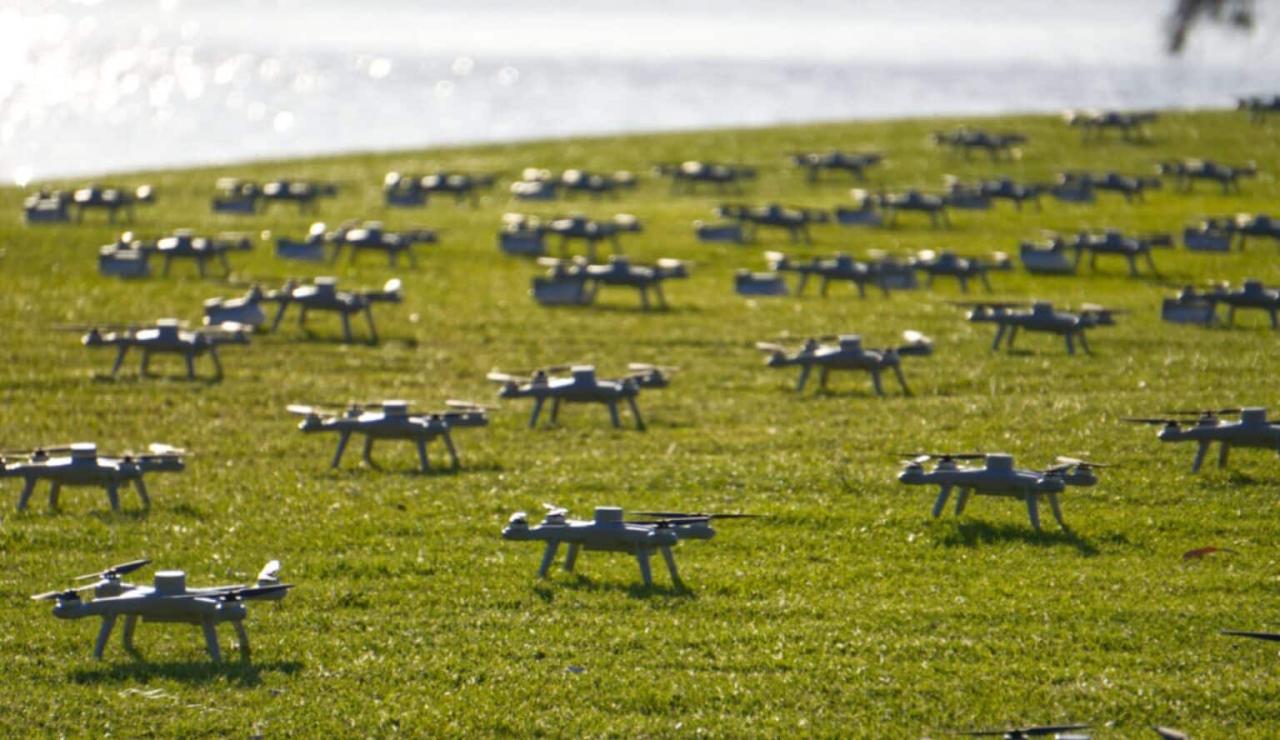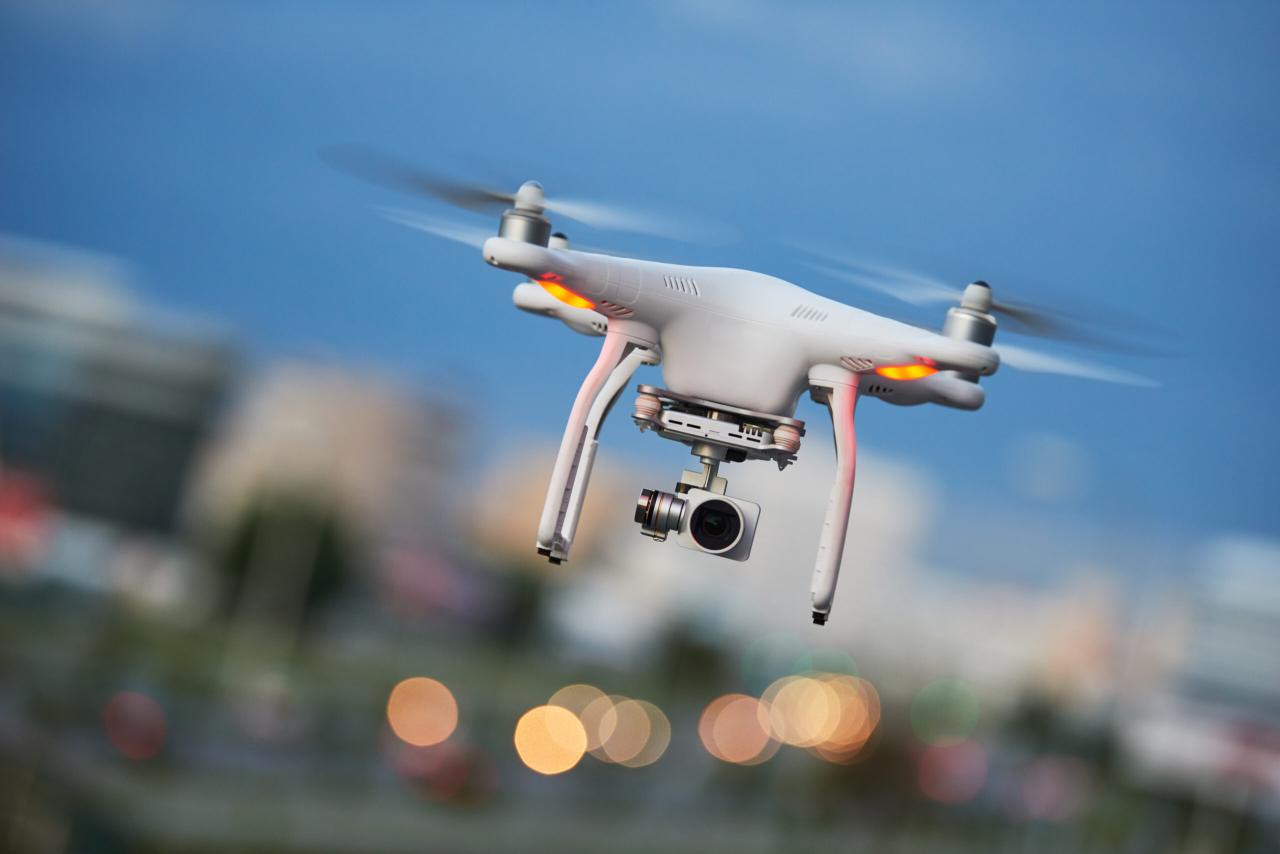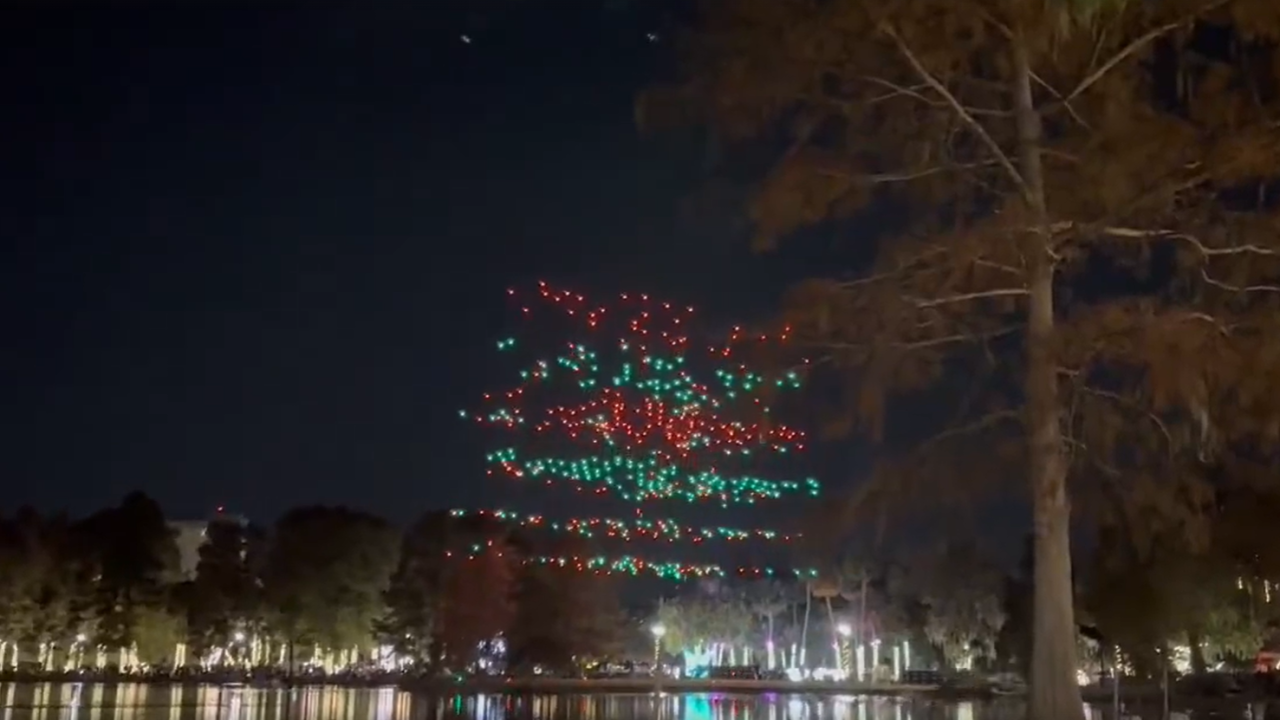Orlando drone show accident: A spectacular drone show turned disastrous when multiple drones malfunctioned, creating a chaotic scene and raising serious questions about safety protocols and technological reliability. This incident, unfolding under [mention weather conditions briefly, e.g., clear skies], involved [number] drones, resulting in [brief description of damage/injuries]. The event highlights the crucial need for robust safety measures and technological advancements within the rapidly expanding drone entertainment industry.
We’ll explore the technical failures, human error possibilities, and external factors that may have contributed to this unfortunate event. We’ll also delve into existing safety regulations, propose improvements, and discuss the long-term impact on the public perception of drone shows and the industry itself. The investigation into the Orlando drone show accident serves as a stark reminder of the potential risks involved in large-scale drone operations.
Accident Overview
The Orlando drone show accident, while not resulting in significant injuries, highlighted potential risks associated with large-scale drone displays. The incident involved a malfunction during a scheduled nighttime performance, leading to a partial loss of control over several drones. This resulted in some drones falling to the ground and others exhibiting erratic flight patterns. The event serves as a valuable case study for improving safety protocols in the burgeoning field of drone light shows.The drones involved were reportedly custom-built for the specific show, utilizing a combination of advanced GPS and communication systems to maintain formation and perform choreographed maneuvers.
The Orlando drone show accident highlights the potential dangers of these increasingly popular displays. Thinking about safety protocols, it’s useful to check out this case study on a related incident: Boy Hit by Drone A Case Study , which underscores the importance of proper safety measures. Learning from such incidents is crucial for preventing future Orlando drone show accidents and ensuring safer drone operations overall.
Specifications regarding their exact model, battery capacity, and individual weight are not publicly available, though it’s understood they were relatively large, high-capacity models capable of carrying bright LED lights. Each drone likely weighed several pounds, and their combined weight contributed to the potential for damage upon impact.Weather conditions at the time of the accident were reported as calm with clear skies and minimal wind.
This is significant because strong winds are a known factor contributing to drone instability and loss of control. The lack of adverse weather conditions points to a technical malfunction as the likely primary cause, rather than an external environmental factor.A significant number of drones, estimated to be in the dozens, were involved in the show. The exact number that malfunctioned and the extent of damage remain unclear due to ongoing investigations.
That Orlando drone show accident really highlighted the risks involved in large-scale drone operations. It’s a crucial reminder of why robust safety protocols are essential, and why businesses like those you’ll find at business events focusing on drone technology are so important. Understanding the tech, regulations, and insurance aspects is key to preventing future incidents like the Orlando mishap.
However, reports indicate some drones sustained damage upon impact with the ground, while others were recovered relatively undamaged. The financial cost of the damaged drones and the disruption to the show are likely substantial.
Causes of the Accident
The Orlando drone show accident, while still under investigation, likely resulted from a confluence of factors, rather than a single, easily identifiable cause. Understanding these contributing elements is crucial for preventing similar incidents in the future. A thorough analysis requires examining technical issues, human error, and environmental influences.
Technical Malfunctions
Potential technical malfunctions could include software glitches within the drone’s flight control system, leading to erratic behavior or unexpected commands. Hardware failures, such as motor malfunctions or battery issues, are also possibilities. The drones’ communication systems, responsible for maintaining contact between the drones and the control station, might have experienced interference or failure, leading to loss of control.
Finally, the possibility of a manufacturing defect in one or more drones cannot be discounted. A thorough examination of the recovered drones and their components will be essential to determine the extent to which technical malfunctions contributed to the accident.
Human Error
Human error is a significant factor in many drone accidents. In this case, potential sources of human error include mistakes in programming the flight path, resulting in collisions or unexpected maneuvers. Inadequate pre-flight checks, overlooking potential hazards, or a lack of sufficient pilot training could also have played a role. Furthermore, the pressure of a large-scale public event could have contributed to rushed decisions or oversight.
A comprehensive review of the operator’s training, pre-flight procedures, and the programming of the flight sequence will be needed.
External Factors
Unexpected weather changes, such as sudden gusts of wind or changes in atmospheric pressure, could have affected the drones’ stability and maneuverability. Radio frequency interference from other electronic devices or sources could have disrupted communication between the drones and the control station, resulting in a loss of control. While less likely, unforeseen obstacles or interference from wildlife could have also contributed to the incident.
A detailed analysis of meteorological data and radio frequency activity during the show is necessary.
Comparison to Similar Incidents
Several past drone accidents share similarities with the Orlando incident, highlighting the importance of learning from past mistakes. The following table compares three past incidents:
| Location | Date | Cause | Outcome |
|---|---|---|---|
| Las Vegas, Nevada | December 31, 2017 | Software malfunction causing loss of control | Multiple drones crashed, minor injuries reported |
| Seoul, South Korea | October 26, 2018 | Pilot error during a complex maneuver | One drone crashed into a building, causing minor damage |
| Dubai, UAE | February 14, 2020 | Strong winds and unexpected turbulence | Several drones lost control, resulting in a temporary show suspension |
Safety Protocols and Regulations

Drone operations, especially in a populated area like Orlando, are subject to a complex web of federal, state, and local regulations, alongside industry best practices. These regulations aim to ensure the safety of both the public and drone operators. Understanding these protocols and their application in the context of the Orlando drone show accident is crucial for preventing future incidents.Existing safety protocols and regulations for drone operations in Orlando largely mirror the Federal Aviation Administration (FAA) Part 107 regulations, which govern the commercial operation of small unmanned aircraft systems (UAS).
These regulations cover aspects such as pilot certification, operational limitations (e.g., maximum altitude, visual line of sight), airspace restrictions, and emergency procedures. Beyond Part 107, Orlando may have additional local ordinances regarding drone flight in specific areas, such as near airports or crowded events. Furthermore, event organizers are responsible for obtaining necessary permits and ensuring compliance with all relevant regulations.
Existing Safety Protocols and Their Application
The specific safety protocols followed during the Orlando drone show are currently under investigation. However, preliminary reports suggest potential violations of existing regulations. For example, there might have been a failure to maintain visual line of sight with all drones, exceeding authorized operational limits, or neglecting to account for potential environmental factors affecting drone performance. A thorough investigation will determine the precise nature and extent of any deviations from established safety protocols.
The investigation will also examine the role of the involved operators’ experience, training, and adherence to established checklists.
Gaps and Weaknesses in Current Safety Regulations
The Orlando drone show accident may highlight several gaps in current safety regulations. One potential weakness is the lack of specific guidance regarding the operation of large drone swarms, which are becoming increasingly common for entertainment purposes. Current regulations may not adequately address the complexities of coordinating multiple drones simultaneously, especially in the face of unexpected technical malfunctions or environmental disturbances.
Another potential gap lies in the enforcement of existing regulations and the effectiveness of pre-flight risk assessments. Improved mechanisms for monitoring compliance and conducting rigorous safety audits are needed. Finally, the regulations might need to account for rapidly evolving drone technology, ensuring that safety protocols keep pace with technological advancements.
Improved Safety Protocols
Based on the lessons learned from the Orlando drone show accident, several improvements to safety protocols are warranted. First, stricter guidelines and more robust oversight are needed for large-scale drone shows, including mandatory simulations and rigorous testing to ensure system reliability and redundancy in the event of malfunctions. Second, enhanced real-time monitoring and control systems should be implemented, allowing for immediate intervention in case of unexpected events.
This might involve the use of advanced sensors, AI-powered collision avoidance systems, and improved communication infrastructure. Third, a more comprehensive risk assessment process should be mandated, considering factors such as weather conditions, potential interference, and the presence of obstacles. This process should be transparent and independently reviewed before any large-scale drone operation. Finally, increased training and certification standards for drone pilots operating in complex environments are necessary.
This could involve specialized training for swarm operations and emergency response procedures.
That Orlando drone show accident got everyone talking about safety regulations, right? It makes you think about the complexities of large-scale operations, especially when considering the news that MNP Acquires BDO in Northwestern Ontario , a merger that also involves significant logistical planning and risk assessment. Hopefully, lessons learned from the Orlando incident will improve safety protocols across all sectors, including accounting firms.
Impact and Aftermath: Orlando Drone Show Accident
The Orlando drone show accident had a significant and immediate impact on the event and its attendees. The sudden malfunction and subsequent crash created a scene of confusion and alarm, abruptly ending what was intended to be a spectacular display. The immediate aftermath involved a rapid shift from excitement to concern, as onlookers processed the unexpected turn of events.The immediate impact was felt both emotionally and physically.
The loud crash and the sight of falling debris likely caused a wave of fear and uncertainty among the audience. The planned, carefully choreographed spectacle transformed into a chaotic and potentially dangerous situation.
Emergency Response and Initial Actions
Local authorities and emergency services responded swiftly to the incident. The response involved a coordinated effort between the Orlando Police Department, the Orlando Fire Department, and other relevant agencies. First responders focused on securing the scene, assessing injuries, and ensuring the safety of those present. This included evacuating the immediate area and establishing a perimeter to prevent further accidents or interference with the investigation.
Injuries and Property Damage
Reports following the accident indicated a range of impacts. While the exact number of injuries varied in initial reports, some attendees suffered minor injuries such as cuts and bruises from debris or in the ensuing panic. More serious injuries were thankfully avoided. The extent of property damage was also limited; primarily involving the damaged drone itself and possibly some minor damage to nearby structures or equipment from falling debris.
The specifics of property damage would require a detailed post-accident assessment.
Timeline of Events Following the Accident
The following bullet points Artikel the key events following the drone show accident:
- Initial Reports (within minutes): 911 calls flooded in reporting the accident, describing the crash and the ensuing chaos.
- Emergency Response (within 10-15 minutes): First responders arrived on the scene, securing the area and attending to the injured.
- Scene Investigation (within hours): Law enforcement and accident investigators began collecting evidence, interviewing witnesses, and examining the damaged drone to determine the cause of the malfunction.
- Public Information Release (within hours to a day): Preliminary information regarding the incident and the response was released to the public via press releases and social media.
- Formal Investigation (days to weeks): A thorough investigation was launched to determine the root cause of the accident, examine safety protocols, and identify areas for improvement in future drone operations.
- Reports and Recommendations (weeks to months): The findings of the investigation were compiled into a formal report, including recommendations for improving safety regulations and operational procedures for similar events.
- Follow-up Actions (ongoing): Based on the investigation’s findings, changes to safety protocols, regulations, and operational procedures were implemented to prevent similar accidents in the future.
Technological Considerations

The Orlando drone show accident highlights the critical need for advanced technological safeguards in drone operations. While the technology itself isn’t inherently flawed, the limitations and potential vulnerabilities in current systems necessitate a comprehensive reassessment of safety protocols and technological advancements. This section explores how technology can be leveraged to prevent future incidents.Technological advancements are crucial in preventing and mitigating drone accidents.
Redundancy and fail-safe mechanisms are paramount, ensuring that even if one system fails, others can take over, preventing catastrophic events. Improved GPS tracking and communication systems are also vital for maintaining situational awareness and preventing collisions.
Redundancy and Fail-Safe Mechanisms
The integration of multiple, independent systems working in parallel is essential. A drone should not rely on a single point of failure for critical functions like flight control, navigation, or communication. For instance, a drone could utilize multiple independent GPS receivers, each with its own processing unit. If one GPS signal is lost or compromised, the other receivers can maintain navigation.
Similarly, redundant flight controllers and power systems can ensure continued operation even in the event of a component failure. This layered approach dramatically reduces the risk of complete system failure.
Improved GPS Tracking and Communication Systems, Orlando drone show accident
Real-time, high-precision GPS tracking is crucial for monitoring drone location and trajectory. Advanced systems should offer sub-meter accuracy, enabling precise control and preventing unintended drift or collisions. Furthermore, robust communication systems are essential for maintaining reliable control and data transmission between the drone and the operator. The use of multiple communication channels, such as cellular networks, Wi-Fi, and dedicated long-range radio links, provides redundancy and resilience against signal interference or loss.
This ensures that the operator can maintain continuous control, even in challenging environments.
Hypothetical Drone with Multiple Redundant Systems
Imagine a drone equipped with a triple-redundant flight control system. This means three independent flight controllers receive the same pilot commands and sensor data. Each controller constantly compares its calculations with the others. If one controller detects a discrepancy or fails, the other two automatically take over, ensuring smooth and safe flight. Furthermore, the drone utilizes two independent GPS receivers, a primary and a secondary, which continuously cross-reference their data to maintain accurate position information.
A backup battery system, capable of powering the drone for at least 10 minutes, ensures safe landing in the event of a primary battery failure. This drone also features two independent communication links – a primary Wi-Fi link and a secondary cellular link – ensuring continuous communication with the ground control station, even if one link is disrupted.
Finally, a failsafe altitude hold mechanism engages automatically if communication is lost, bringing the drone to a pre-set safe altitude. This multi-layered approach dramatically increases the safety and reliability of the drone’s operation.
Public Perception and Future Implications

The Orlando drone show accident sparked a wave of public reaction, ranging from awe at the spectacle to concern over safety and regulation. Initial responses were dominated by social media, with videos of the incident rapidly spreading, generating both excitement and apprehension about the future of drone technology. This event significantly impacted the public perception of drone shows, raising questions about the risks involved and the adequacy of existing safety measures.The accident’s long-term implications for the drone industry are multifaceted.
It’s likely to lead to increased scrutiny of safety protocols and regulations, potentially slowing down the rapid growth of the commercial drone show sector. Insurance costs for drone show operators could rise, and obtaining permits might become more challenging. Furthermore, the incident could trigger a reassessment of the technological limitations of current drone systems and the need for improved fail-safe mechanisms.
Impact on Future Drone Shows
The Orlando accident will undoubtedly influence the future of drone shows and similar events. We can anticipate stricter regulations, more rigorous safety testing, and potentially higher insurance premiums. Companies will likely invest more heavily in redundant systems and fail-safe technologies to mitigate the risk of similar incidents. The public’s willingness to attend drone shows might decrease until a stronger track record of safety is established.
This could lead to a shift in the types of drone shows produced, with a greater emphasis on smaller, less ambitious displays until public confidence is restored. The event could also accelerate the development and adoption of more sophisticated safety technologies, such as improved GPS systems, obstacle avoidance technologies, and automated emergency landing procedures.
That Orlando drone show accident really highlighted the importance of reliable tech. If you’re looking to upgrade your own drone setup, maybe snag some Boxing Day deals – check out the awesome offers at Drone Boxing Day Sale Best Deals & – before your next flight. Hopefully, you can avoid any similar mishaps by investing in better equipment and practicing safe flying techniques.
Hypothetical Press Release Following a Similar Incident
FOR IMMEDIATE RELEASE[Drone Show Company Name] Responds to Drone Malfunction at [Location][City, State] – [Date] – [Drone Show Company Name] acknowledges the incident involving a drone malfunction during a show at [Location] on [Date]. While no injuries were reported, we deeply regret any disruption or concern this may have caused. Our immediate priority is a thorough investigation to determine the cause of the malfunction. We are fully cooperating with authorities and independent experts to conduct a comprehensive review of our safety protocols and operational procedures.
This investigation will include a detailed analysis of the drone’s systems, flight data, and weather conditions. We are committed to enhancing our safety measures to prevent similar incidents in the future. This includes [Specific actions, e.g., implementing new redundancy systems, investing in advanced safety technology, reviewing pilot training programs]. The safety and well-being of our audiences and communities remain our top priority.
We will provide updates as the investigation progresses and will take all necessary steps to ensure future shows are conducted with the highest standards of safety.
Concluding Remarks

The Orlando drone show accident serves as a cautionary tale, underscoring the need for stringent safety protocols, advanced technology, and continuous improvement in the drone industry. While drone shows offer breathtaking spectacles, prioritizing safety and addressing potential risks is paramount to ensuring future events are both spectacular and safe. The lessons learned from this incident should shape the future of drone operations, leading to more robust regulations and technological advancements that minimize the likelihood of similar accidents.
The ongoing investigation and resulting changes will undoubtedly influence how drone shows are planned and executed globally.
Query Resolution
What type of drones were involved in the Orlando drone show accident?
This information will be detailed in the main body of the article, specifying the model and manufacturer.
Were there any injuries reported?
The extent of injuries, if any, will be covered in the section detailing the accident’s impact and aftermath.
What is the current status of the investigation?
The article will include an updated timeline of events following the accident, including the progress of any investigations.
How will this accident affect future drone shows?
The article will explore the potential long-term implications for the drone industry and regulations, including the effect on future drone show planning and execution.
